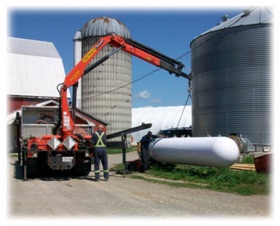Propane Tanks and Safety


- Propane is heavier than air, and if a leak occurs, propane will settle in low-lying areas such as ditches, window wells, trenches, and sumps in absence of ventilation.
- Eco-friendly... Propane is insoluble in water and presents minimal risk to soil and ground water supplies in the event of a leak or spill.
- Propane that is sold commercially is odourized with ethyl mercaptan, which smells like rotten eggs, skunk, or boiling cabbage so that leaks can be detected.
- Propane is a by-product of natural gas processing and crude oil refining. It is extracted and used as a gas, but stored and transported as a liquid under pressure.
When considering propane for your home, you can also take into account all of the appliances that can be hooked to your system: barbecues, boilers, dryers, fireplaces, fryers, furnaces, generators, indoor lighting, pool heaters, refrigerators, space heaters, stoves, water heaters, and more. See the chart below for the clearances you will need for your Propane tanks...
| Distance to source of ignition | Distance to building openings | Distance to another tank | Distance to property line | Distance to building wall | |
|---|---|---|---|---|---|
| 420LB Upright Tank | 10 feet | 3 feet | None | None | None |
| 500G to 1000G Horizontal Tank | 10 feet | 10 feet | 3 feet | 10 feet | 10 feet |
Crop Dryers have different clearances. Please call one of our offices for more information.